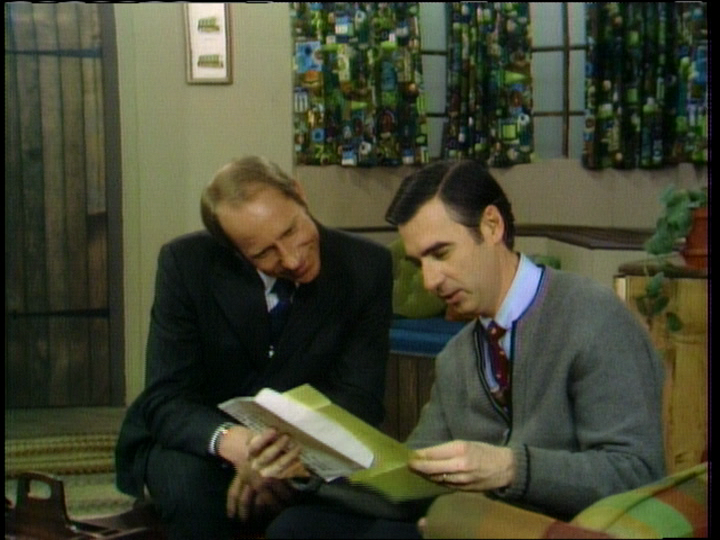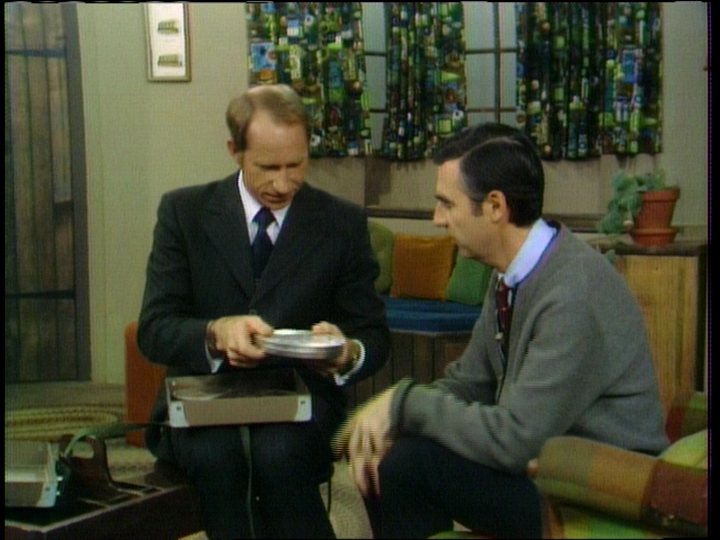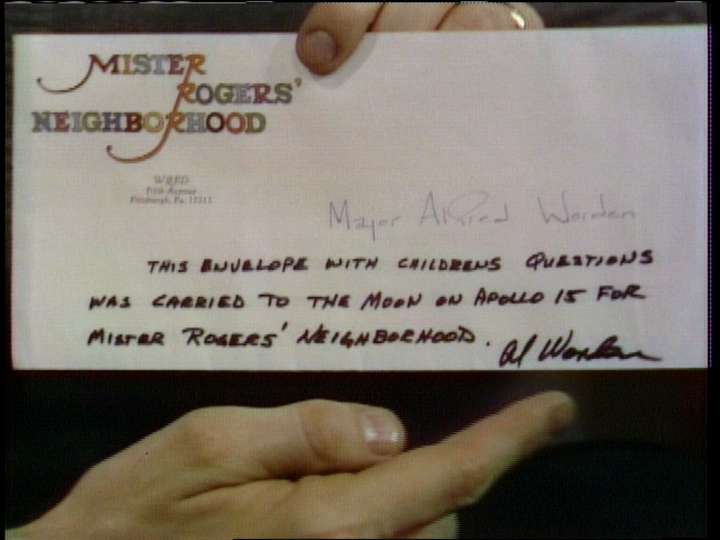That Time Apollo Astronaut Al Worden Landed in 'Mister Rogers' Neighborhood'
This episode is a magical melding of worlds.
In 1971, Apollo astronaut Al Worden flew to the moon, carrying a letter from Mr. Rogers with him.
The beloved legacy of Fred Rogers, famously Mr. Rogers from the TV show "Mister Rogers' Neighborhood," has reentered the mainstream following the 2018 documentary "Won't You Be My Neighbor?" and with the feature film "A Beautiful Day in the Neighborhood" premiering today (Nov. 22). With that return, we remember the time that Worden crossed paths with Mr. Rogers.
Soon after returning from the moon, Worden — who orbited the moon as command module pilot of NASA's Apollo 15 mission — visited Mr. Rogers in his show's famous neighborhood. According to Worden in his book "Falling to Earth," (Smithsonian Books, 2011), the idea was all his.
Related: Driving on the Moon: Photos of NASA's Lunar Cars

"NASA was leery of letting little children witness live launches and imposed age restrictions. This limitation may have protected them, but it also missed an opportunity to engage them. I knew a Saturn V launch was a pretty astounding experience, and children grasped the excitement of flying to the moon in ways that adults did not. If we wanted public support for NASA and space travel, we need to inspire and inform the kids," a passage from Worden's book reads. "The producer put me right through to Fred Rogers, the show's much-loved host. We chatted for a few minutes, I explained my idea, and he replied that it fit perfectly with a series he was filming about parents going away."
And the collaboration was a roaring success, as the magical combination of Wordens' low-key, easy charm and Rogers' soothing sincerity resulted in an accessible, exciting look into what it's like to be an astronaut.

Arriving to the neighborhood
Worden first appeared in the episode (Episode 1,229 of the series) in the Neighborhood of Make-Believe and later met Mr. Rogers at the door with mailman Mr. McFeely. "It's nice to be here, Fred," Worden said. "I brought something back with me that you and I looked at and discussed before my flight, and I thought maybe you'd like to have it back just as I promised."
Worden revealed an envelope, which he handed to Rogers. "I'd like you to see this envelope because it means a lot to me," Rogers said to the camera. "It says, 'This envelope with children's questions was carried to the moon on Apollo 15 for "Mister Rogers' Neighborhood." Al Worden.'"
Get the Space.com Newsletter
Breaking space news, the latest updates on rocket launches, skywatching events and more!
Rogers and Worden filmed together before Worden flew to the moon, and Rogers asked Worden questions that children who watch his show had sent in. But, as Worden describes in his book, the astronaut couldn't answer all of them before his journey.
"I asked Fred to let me take the list into space. I would think about them during the flight, I promised, and then answer when I returned," Worden added in "Falling to Earth." revealing that he actually asked Rogers if he could bring the list of questions to space.
Back on Earth, and with Rogers in the neighborhood, Worden answered some of those questions during the episode.

First off, Rogers asked Worden one of the questions that the astronaut had initially answered before launching. "Do you think you'll be scared at all when you fly to the moon? Do you remember how you answered that one?" Rogers said
They showed Worden's preflight response, in which he said, "I can't put it in good words probably, but the answer to the question is yes." But, as he explained to Rogers, Worden felt a little different once back on Earth. "Well, you know, after you know about something, it's not as scary as you thought it could be. And after you do it, it's not as scary as before," Worden said, to which Rogers responded "kind of like riding a bike."
Bringing space to Earth
In addition to bringing the space-flown letter, Worden came bearing a video reel of an extravehicular activity (EVA) from his mission. Worden, with Rogers' help, talked the audience through the EVA, explaining all of the details to the show's young viewers.
The astronaut went on to describe his and his crews' roles during the mission. He described how astronauts James Irwin and Dave Scott landed on the moon and drove the lunar buggy around the lunar surface while Worden stayed in the command module for over three days traveling around the moon.
Rogers and Worden discussed how the astronaut felt about traveling alone around the moon. While it would be fun to "drive a little car down on the moon's surface," Worden said, he had an important task to accomplish to make sure the mission would be a success and everyone would be safe.
Before departing for the neighborhood and joining Rogers and his wife for dinner, as the two men discuss in the show (though it's unclear whether they did, in fact, have dinner together), Worden shared that he brought some of his space food for Rogers to try. And he and Rogers did, in fact, regroup in follow-up episodes where Worden brought space food and items like his spoon from flight and his astronaut sunglasses, which both Worden and Rogers tried on.
As Worden said in his book, "kids were fascinated by space food, so I took some to the show to reconstitute, and Fred and I ate it right there on the air. I took a large moon rock to another taping, so the kids could look at it. Those shows did a lot of good, bringing a human element into spaceflight. Many of the ideas evolved into a children’s book that I wrote in 1974, named 'I Want to Know About a Flight to the Moon,' (Doubleday, 1974), Fred wrote the foreword."
"Mister Rogers' Neighborhood" is currently available to stream for free on PBS Kids and can also be found on Amazon Prime Video and iTunes Video.
Correction Note: An earlier version of this story stated that Apollo 15 astronaut Al Worden walked on the moon. Worden remained in orbit as command module pilot as crewmates David Scott and Jim Irwin walked on the lunar surface.
- Apollo 15 in Photos: A Moon Landing and the 1st Lunar Car for Astronauts
- Driving on the Moon: The 40-Year Legacy of NASA's First Lunar Car
- Space History Photo: Apollo 15 Rollout
Follow Chelsea Gohd on Twitter @chelsea_gohd. Follow us on Twitter @Spacedotcom and on Facebook.

Join our Space Forums to keep talking space on the latest missions, night sky and more! And if you have a news tip, correction or comment, let us know at: community@space.com.

Chelsea “Foxanne” Gohd joined Space.com in 2018 and is now a Senior Writer, writing about everything from climate change to planetary science and human spaceflight in both articles and on-camera in videos. With a degree in Public Health and biological sciences, Chelsea has written and worked for institutions including the American Museum of Natural History, Scientific American, Discover Magazine Blog, Astronomy Magazine and Live Science. When not writing, editing or filming something space-y, Chelsea "Foxanne" Gohd is writing music and performing as Foxanne, even launching a song to space in 2021 with Inspiration4. You can follow her on Twitter @chelsea_gohd and @foxannemusic.









